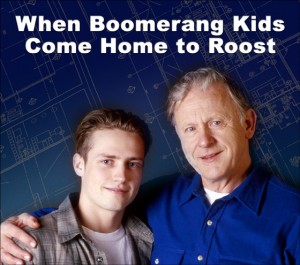What to Do When Adult Children Crowd Back into Your Empty Nest
Just as building an in-law apartment creates a safe haven for an aging parent, constructing a boomerang apartment puts needed space— and privacy— between parents and a returning adult child.
Why Kids Boomerang
Young adults, who lived on their own for a time but then move back in with their parents, are known as “boomerang kids.”
 An incredible 57 million Americans now live in multi-generational homes with elderly parents, grown children, or grandchildren gathering into an increasingly crowded home.
An incredible 57 million Americans now live in multi-generational homes with elderly parents, grown children, or grandchildren gathering into an increasingly crowded home.
The reasons for the return to the nest vary, but economic hardship tops the list.
- 20% of young Americans in their 20s and 30s now live with their parents.
- Skyrocketing college costs leave many graduates burdened by sizable student’s loans.
- 45% of 25-year-olds carry large debts.
- Downsizing, outsourcing, and stock market downturns have reduced employment opportunities for many young people.
- A college degree no longer guarantees a bright future with greater earning power. Today’s graduates earn substantially less than their predecessors do.
- The diminishing buying power of the dollar creates greater pressure on those with lower-waged, entry-level jobs.
- 60% of all young adults in the U.S. have accepted some financial help from their parents.
- Far fewer young adults marry in their 20s than in previous generations. Some of those who married later divorced, with one or both of the spouses returning to live with parents for a time.
Coping with Multi-generational Living Arrangements
Parents who have adjusted to their “empty nests,” and started independent lives often find it challenging to share space with their grown children. Young adults, who have lived for some time on their own, also experience difficulty returning to the family, where they no longer feel like adults.
Constructing a “boomerang apartment”— a separate dwelling for the returning young adult— may be the solution to harmonious living across the generation gap.
Building an apartment-sized backyard bungalow (also known as an accessory dwelling unit, or ADU) provides many advantages for multi-generational households:
- Privacy for both parents and their grown child.
- Shares expenses, with each household paying their own utilities.
- Increased property value for the parents.
- Revenue for parents, who may rent the apartment at a reduced rate to the boomerang son or daughter.
- Creates options when the boomerang kid goes back out on their own. The parents may rent the backyard dwelling for added income. Alternatively, they may choose to use the space as a guesthouse, man cave, or in-law apartment for a family elder.
- Promotes accountability for the young adult, who remains responsible for his or her own household expenses and care. It prepares grown child for launching back into the world on their own. (Adult children returning home can too easily slip into former adolescent patterns, shifting too many responsibilities back onto the parents.)
You must do two things before planning a boomerang apartment.
First, check with your local home association and permitting authorities on guidelines and restrictions for ADUs.
Secondly, discuss the details and expectations in advance with the adult child. Have an agreement— in writing— outlining the restrictions and responsibilities of each party, to avoid misunderstandings later.
A Building a Boomerang Apartment with Steel
Consider building your boomerang apartment with steel framing.
RHINO steel buildings are strong, affordable to build, economical to operate, durable, low maintenance, and attractive. Metal buildings can be finished to complement your current home, blending beautifully into the surrounding neighborhood.
Please phone RHINO Steel Building Systems now at 940.383.9566 for helpful suggestions and a free quote. You can rely on our expertise, our many years of experience, and our superior building products.
Call RHINO today!
